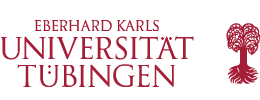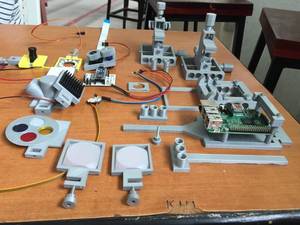Tübingen neuroscientists develop inexpensive, self-manufactured lab equipment
Tübingen neuroscientists develop inexpensive, self-manufactured lab equipment
 Laboratory equipment is one of the largest cost factors in neuroscience. However, many experiments can be performed with good results using self-assembled setups with 3-D printed components and self-programmed electronics. The inexpensive system called “FlyPi” developed by André Maia Chagas and Tom Baden allows for many standard lab processes including light and fluorescence microscopy, optogenetics, thermogenetics, and behavioural studies in small animals (e.g. round-worms, fruit flies, zebrafish larvae). The FlyPi system provides modular, low-cost options for research as well as training and teaching purposes. Assembly and usage instructions are made available free of charge via open source platforms.
Laboratory equipment is one of the largest cost factors in neuroscience. However, many experiments can be performed with good results using self-assembled setups with 3-D printed components and self-programmed electronics. The inexpensive system called “FlyPi” developed by André Maia Chagas and Tom Baden allows for many standard lab processes including light and fluorescence microscopy, optogenetics, thermogenetics, and behavioural studies in small animals (e.g. round-worms, fruit flies, zebrafish larvae). The FlyPi system provides modular, low-cost options for research as well as training and teaching purposes. Assembly and usage instructions are made available free of charge via open source platforms.
In modern neuroscience, small animals provide insights into basic functions of the nervous system. The translucent larvae of zebrafish, the fruit fly Drosophila, or the tiny nematode (roundworm) Caenorhabditis elegans are easy to keep in large numbers. More importantly, their genomes have been completely sequenced, allowing many modifications, such as for optogenetics. With this technique nerve cells are genetically programmed to react to light, so brain areas or even individual nerve cells can in effect be “switched on” or “off” – in the live organism. This allows specific identifications of the nerve cells responsible for controlling specific functions and behaviours. The intricate equipment necessary for these experiments includes light sources with defined wavelengths and adjustable intensities; powerful cameras and microscopes; and a custom-tailored so-called “arena” for behavioural studies of live specimens. A lab can easily spend tens to even hundreds of thousands of Euros on commercially available solutions, confining top-level research and scientific training to well-endowed institutes in rich countries.
 The inexpensive system called “FlyPi” developed by André Maia Chagas and Tom Baden (Credit - Tom Baden / CIN)In a joint initiative, neuroscientists of the Tübingen Werner Reichardt Centre for Integrative Neuroscience (CIN) and Institute for Ophthalmic Research and the University of Sussex in Brighton have now presented the “FlyPi”. The design is based on a 3-D printed framework holding a Raspberry Pi computer and camera, cheap LEDs for lighting and simple lenses, as well as optical and thermal control circuits based on Arduino, an open-source electronic prototyping platform. Taken together, the components cost less than 100 Euros for the basic system, which can carry many add-on modules which still merely double the total. Commercially available solutions are obviously more sophisticated in some aspects. For example, spatial resolution in fluorescence microscopy ranges in the micrometers, where state-of-the-art confocal or 2-photon microscopes reach tenths of micrometers. But this factor of ten in spatial resolution compares well to a factor of up to 5,000 in cost. The FlyPi performs very well in many standard tasks needed in neuroscience labs on a day-to-day basis and is more than adequate for teaching purposes. Due to its modular nature, it can be fitted with more costly components to improve certain performance aspects – spatial resolution, for example.
The inexpensive system called “FlyPi” developed by André Maia Chagas and Tom Baden (Credit - Tom Baden / CIN)In a joint initiative, neuroscientists of the Tübingen Werner Reichardt Centre for Integrative Neuroscience (CIN) and Institute for Ophthalmic Research and the University of Sussex in Brighton have now presented the “FlyPi”. The design is based on a 3-D printed framework holding a Raspberry Pi computer and camera, cheap LEDs for lighting and simple lenses, as well as optical and thermal control circuits based on Arduino, an open-source electronic prototyping platform. Taken together, the components cost less than 100 Euros for the basic system, which can carry many add-on modules which still merely double the total. Commercially available solutions are obviously more sophisticated in some aspects. For example, spatial resolution in fluorescence microscopy ranges in the micrometers, where state-of-the-art confocal or 2-photon microscopes reach tenths of micrometers. But this factor of ten in spatial resolution compares well to a factor of up to 5,000 in cost. The FlyPi performs very well in many standard tasks needed in neuroscience labs on a day-to-day basis and is more than adequate for teaching purposes. Due to its modular nature, it can be fitted with more costly components to improve certain performance aspects – spatial resolution, for example.
The developers of the FlyPi system, André Maia Chagas and Tom Baden, share a keen interest in spreading “open labware”. That is what the growing community of scientists interested in open source, DIY engineering and gadgeteering calls projects such as this. For years now, and together with co-author Lucia Prieto Godino of the University of Lausanne, the two scientists have taught courses in 3 D printing, programming and DIY lab equipment at universities in Kenya, Uganda, Ghana, Nigeria, South Africa, Sudan and Tanzania. “These institutions have little money to spend on costly equipment”, says Baden. “We think it is very important that neuroscientific training and research open up to larger numbers of students and junior scientists in these developing countries. So we hope that, with open labware such as our FlyPi, we can offer a starting point.”
Publication:
André Maia Chagas, Lucia Prieto Godino, Aristides B. Arrenberg, Tom Baden: The 100 Euro Lab: A 3-D Printable Open Source Platform for Fluorescence Microscopy, Optogenetics and Accurate Temperature Control during Behaviour of Zebrafish, Drosophila and C. Elegans. PLoS Biology (in press). 18 July 2017.
Authors:
André Maia Chagas
Werner Reichardt Centre for Integrative Neuroscience (CIN), University of Tübingen
andre.chagas[at]klinikum.uni-tuebingen.de
Tom Baden
Sussex Neuroscience, School of Life Sciences, University of Sussex, Brighton UK
Werner Reichardt Centre for Integrative Neuroscience (CIN), University of Tübingen
Tübingen Institute for Ophthalmic Research
t.baden[at]sussex.ac.uk
http://www.badenlab.org
Links:
Open Labware (maintained by T. Baden): www.Open-Labware.net
Open Neuroscience (maintained by A. M. Chagas): www.Openeuroscience.com
TReND in Africa: www.TReNDinAfrica.org
PLoS Open Hardware Collection (Curated by A. M. Chagas and T. Baden): http://collections.plos.org/open-source-toolkit-hardware
Press Contact CIN:
Dr. Paul Töbelmann
University of Tuebingen
Science Communication and Public Outreach
Werner Reichardt Centre for Integrative Neuroscience (CIN)
Tel.: +49 7071 29-89108
paul.toebelmann[at]cin.uni-tuebingen.de
www.cin.uni-tuebingen.de
The University of Tübingen
The University of Tübingen is one of eleven universities given the title of excellent under the German government’s Excellence Initiative, and ranks well in international comparisons.
Tübingen is one of the world’s foremost locations for neuroscientific research. Along with translational immunology and cancer research, microbiology and infection research, and molecular plant biology, it makes Tübingen a cutting-edge center of research in the Life Scienc-es. Further areas of core research are in Geoscience and Environmental Science; Archaeology and Anthropology; Language and Cogni-tion; and Education and the Media. More than 28,400 students from Germany and around the world are currently enrolled at the University of Tübingen, enjoying a broad spectrum of some 300 different study programs.
The Werner Reichardt Centre for Integrative Neuroscience (CIN)
The Werner Reichardt Centre for Integrative Neuroscience (CIN) is an interdisciplinary institution at the University of Tübingen funded by the DFG’s German Excellence Initiative program. Its aim is to deepen our understanding of how the brain generates functions and how brain diseases impair them, guided by the conviction that any progress in understanding can only be achieved through an integrative approach spanning multiple levels of organization.
The University of Sussex’s School of Life Sciences
The University of Sussex’s School of Life Sciences is one of the largest academic schools at the University of Sussex. With 96 per cent of its research rated as world leading, internationally excellent or internationally recognised (REF 2014), it is among the leading research hubs for the biological sciences in the UK. The School is home to a number of prestigious research centres including Sussex Neurosci-ence, the Genome Damage and Stability Centre and the Sussex Drug Discovery Centre, where academics work with industry to translate scientific advances into real-world benefits for patients.
Eberhard Karls Universität Tübingen
Public Relations Department
Dr. Karl Guido Rijkhoek
Director
Antje Karbe
Press Officer
Phone +49 7071 29-76789
Fax +49 7071 29-5566
antje.karbe[at]uni-tuebingen.de
www.uni-tuebingen.de/aktuell
- Tags:
- 3-D printing
- Andre Maia Chagas
- Arduino
- Aristides B. Arrenberg
- DIY lab equipment
- FlyPi
- Ghana
- Institute for Ophthalmic Research
- Kenya
- Lucia Prieto Godino
- neuroscience
- Nigeria
- open health
- open labware
- open source
- open source software (OSS)
- open-source electronic prototyping platform
- Raspberry Pi
- self-manufactured lab equipment
- self-programmed electronics
- South Africa
- Sudan
- Tanzania
- Tom Baden
- Tübingen Werner Reichardt Centre for Integrative Neuroscience (CIN)
- Uganda
- University of Lausanne
- University of Sussex in Brighton
- University of Tübingen
- Login to post comments